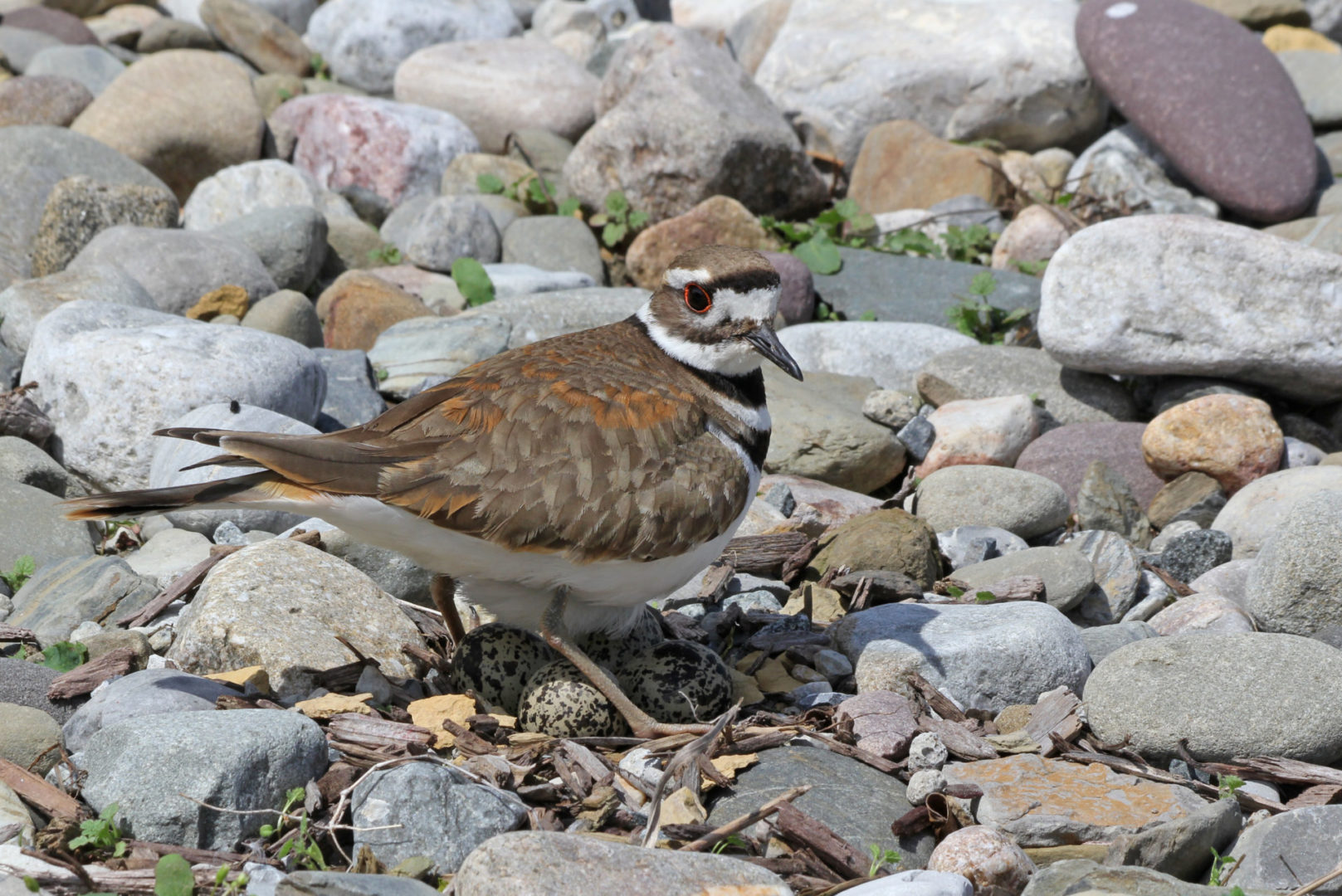
KILLDEER ARE robin-sized, but their long legs make them appear larger. Photo by Mark Nale | For the Gazette

KILLDEER ARE robin-sized, but their long legs make them appear larger. Photo by Mark Nale | For the Gazette
One of our noisiest birds is the killdeer (Charadris vociferus). If you are unfamiliar with this inland version of the “shorebird” plover family, listen carefully, for an excited killdeer repeats its name “kill-deer,” “kill-deer,” over and over — up to 80 times per minute. Even its species name, vociferus, attests to its noisy nature.
Killdeer are common, but fascinating birds. In appropriate habitat, I have seen them all over Centre and nearby counties. Look for killdeer where there is little or no taller vegetation — such as lawns, golf courses, railroad right-of-ways, parking lots and pastures.
The highest number that I have ever seen in one place was 21, spotted last October on the swimming beach and adjacent lawn at Shawnee State Park.
Killdeer are handsome birds, sporting medium-brown backs and clean, white breasts accented with two black neck bands. Killdeer are robin-sized, but their long legs make them appear larger.
They measure about 10 inches from the tip of their orange tails to their dark beaks. Killdeer have relatively large eyes that appear red-orange in bright light.
Their eyes are used to spot their insect prey.
The killdeer is a plover, and other members of this genus spend most of their time along water.
Although killdeer sometimes frequent lakes, marshes and the ocean, they are more often found far away from water.
During the breeding season, they are found from coast to coast, with their range reaching northern Canada, southern Alaska and Central America. They nest all over Pennsylvania, except in our most densely forested areas. As the Cornell Lab of Ornithology puts it, “This is a shorebird that you can see without going to the beach.”
With exception to the southeastern corner of this state, killdeer are found south of Pennsylvania during the winter months. They are found year-round in the Carolinas, Virginia, Texas and all other southern states, and in Mexico. They also winter as far south as Central America and northern South America.
Males usually migrate to Pennsylvania by mid-March, and females return a few days later, although cold weather and snow may delay their northern movement. Males usually return to the same area within which they lived the previous year. Birds pair up and nesting begins in April, and many pairs are nesting now.
The word “nest” is actually a bit of an exaggeration when it comes to the killdeer. Eggs, usually four, are laid in a shallow depression in open areas. The female may select a railroad bed, gravel parking lot, garden, pasture or golf course for a nest. One spring, a pair successfully nested on the gravel roof of a local school. The nest pictured with this column was constructed in the middle of “hardscape” near condominiums.
Killdeer often make several mock nests before choosing one in which to lay their eggs. This might serve to confuse predators. They are also known to add materials (usually light-colored) to the nest after the eggs have been laid.
The killdeer’s dark-speckled eggs are well-camouflaged and nearly invisible. The eggs are also very large for a bird the size of a killdeer. Both sexes share responsibility for incubating their eggs for 24 to 26 days before they hatch — nearly twice as long as a robin. The eggs contain more yolk, which — coupled with a longer incubation — allows the young to develop more fully before they greet the world.
Unlike most birds, but common with ground-nesters, the killdeer family leaves the nest within a few hours of hatching. If you think that the adults are comical-looking as they run along the ground hunting for food, you should see the little ones — tiny balls of downy feathers on miniature stilts. The youngsters are difficult to photograph. Just when you get close enough for a photo, they run farther away.
If a predator or human approaches the young family or nest, the adult killdeer will make a distress call and drag one or both wings, looking like a bird unable to fly or one that is about to die. The act is designed to lure a predator away from the nest or young, and it is quite convincing. One of the birds also does this if you approach its mate when it is incubating its eggs.
Killdeer are proficient swimmers, even in swiftly flowing water. The oldest known killdeer was nearly 11 years old.
If you are unable to spot a killdeer before spring transitions into summer, just look and listen for them next spring in open, grassy areas and parking lots. You might be privileged to witness their broken-wing act.
Weather permitting, Mark Nale and Bridget Whyte will be leading two nature walks (1 p.m. and 3 p.m.) as part of Centred Outdoors’ Family Fishing Picnic on June 5, at Tussey Mountain.
Receive all the latest news and events right to your inbox.

403 S. Allen St.
State College, PA 16801
(814) 238-5051
